Ecological concept, Ecological factors, their effects on the ecosystem and instrument use in measuring them.

Ecological concept, Ecological factors, their effects on the ecosystem and instrument use in measuring them.
Ecological concept.
The biosphere is the area of the earth (including sea, freshwater, and land) and the atmosphere where life exists
- Atmosphere: it is the layer of air that envelopes the earth
- Hydrosphere: it is the part of the earth composed of water
- Lithosphere: it is the rocky and soil part of the earth
Environment: it consists of everything in the immediate surrounding of an organism e.g., water, light, temperature, etc.
An ecosystem is a natural unit, which is made up of both living and non-living things interacting together to produce a stable system
Habitat: it is a particular locality/specific place within an environment where an organism naturally lives successfully. E.g., pond, seashore, rainforest, freshwater, etc.
Population: it is the total number of individuals of the same species, living together in a particular habitat e.g., a population of weaver birds living in a tree.
OR
A population is defined as all the organisms belonging to the same species within an area at the same time.
Community: it refers to all populations of different species of organisms, living together and interacting with one another in a habitat e.g., termites, earthworms, and bacteria form a community in the soil.
Ecological niche: it is the exact place an organism lives including its behavior, feeding habit, breeding habits
Dominant species: they are organisms whose population outnumbers other species in a community. The community is named after the dominant species. E.g., a cocoa tree community, a grassland community
Ecosystem: it is made up of all the living and non-living factors in a habitat, interacting together to produce a stable system. Examples of ecosystems include grassland, forest, pond, sea, etc.
Biome: it is a large natural area of an ecosystem with a particular climate e.g., tropical rainforest, desert etc.
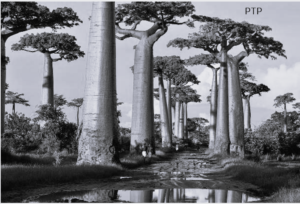
ECOLOGICAL FACTORS
These are factors that affect the lives of organisms living in their habitat, development, distribution, and behavior. These factors can be:
- Abiotic factors
- Biotic factors
Abiotic factors
These are the non-living components of a habitat or ecosystem that affect the lives of organisms. Examples are
- Light
- Temperature
- Rainfall
- Humidity
- Wind
- Pressure
- Hydrogen ion concentration
- Degree of salinity
- Slope of land
- Altitude (height)
- Carbon (iv)oxide concentration
- Oxygen concentration
- Concentration of pollutants
- Turbidity and depth of water
Temperature
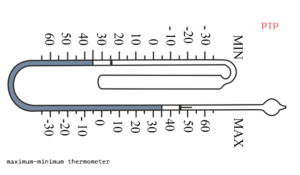
Temperature is the measure of the degree of coldness or hotness of a body or system.
Temperature is measured with a thermometer; however, the maximum-minimum thermometer is used to measure the highest and lowest temperature. (In a day, week, or month).
It is measured in Degrees Celsius, Kelvin, or Degrees Fahrenheit.
An increase in the temperature in an ecosystem can be caused by;
- Poor ventilation
- Low altitude
- High intensity of sunlight.
- Warm ocean current
- Poor vegetation cover.
The low temperature in an ecosystem can be due to;
- Cold current from the ocean.
- Sunlight intensity, when it is low or there is shade.
- Well ventilation and adequate circulation of cold air.
- Wet weather conditions, high humidity, or rain.
How temperature affects plants and animals in an ecosystem
- Increase in temperature increases the rate of metabolism in organisms
- Increase in temperature increases the rate of transpiration in plants
- Increase in temperature increases the growth rate of animals such as toads and houseflies
- Increase in decay in organic matter as temperature increases
- Evaporation of water in soil, river, and lakes also increases as the temperature rises
Rainfall
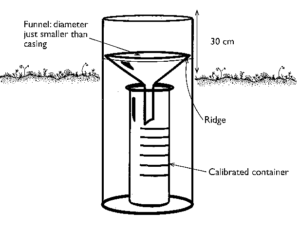
Rainfall is the precipitation of water as a liquid resulting from the condensation of warm clouds.
Rainfall is measured with a rain gauge
How rainfall affects plants and animals in an ecosystem
- It makes water available for plants
- Rainfall patterns affect the distribution of organisms
- Rainfall variations can result in drought or floods which can destroy vegetation and animals
- Onset of rainfall induces winged termites to go on a nuptial flight
- Rainfall determines the salinity of aquatic habitats which determines the distribution of organisms
- Rainfall affects the light intensity and affects the activities of organisms
- Rainfall affects temperature which also affects the distribution and other activities of organisms
- Amount of rainfall can determine the level of soil erosion which affects plant growth and destroy habitats
- Amount of rainfall affects humidity which affects the transpiration
- Amount of rainfall affect turbidity(transparency)of water bodies which affect distribution of organism
- Rainfall provides breeding grounds for toads and frogs to lay their eggs
- Rainfall increases the turbidity of water and also causes soil erosion and leaching
Wind
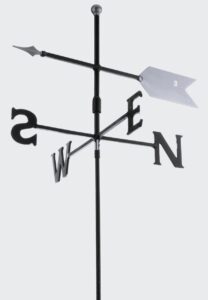
The wind is the air in motion.
The speed of wind is measured with an anemometer.
The direction of the wind is measured with a wind vane.
Effects of Wind on Plants and Animals in an Ecosystem
- It increases the rate of evaporation or transpiration/desiccation of organisms
- Strong wind causes soil erosion
- It serves as an agent of pollination
- It also serves as an agent of seeds and fruits dispersal
- Strong winds may uproot or break off branches of plants
- Facilitate the spread of air-borne diseases
- Has the means of spreading bushfires
- Wind spread pollutants in the ecosystem.
Altitude
It refers to the height of the land above sea level
How Altitude affects organisms
- As altitude increases, atmospheric pressure and oxygen level decreases and breathing is affected
- Organisms at a higher altitude experience low temperatures and strong winds
- Altitude affects the distribution of organisms.
How animals are adapted to high altitudes
- Individuals have more red blood cells
- They develop larger ventricles to pump blood more efficiently
- They can also breathe fast
- Have a larger heart and chest
Organisms that live at higher altitudes include eagles
Turbidity
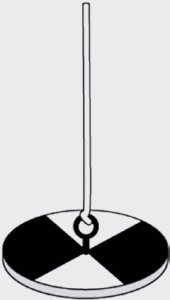
Turbidity is the measure of the cloudiness or muddiness of a water body.
It is measured with a Secchi disc.
Turbiaffects the rate of photosynthesis of aquatic plants
It affects the vision of aquatic animals.
Atmospheric Pressure
It is the pressure exerted on objects on the earth’s surface by the atmosphere
Atmospheric pressure is measured with a barometer
The atmospheric pressure increases with increasing depth and decreases with increasing altitude.
Light intensity:
Light intensity on land is measured by a photometer
In water, light intensity is measured with a light-intensity probe
Effects of Light on Organisms
- Termites swarm at night to avoid birds preying on them
- Humans can produce vitamin D by the actions of ultra-violet light rays on the skin cell
- Lights also affect the distribution of organisms in habitats
- Light affects the rate of photosynthesis of plants
- Light affects the vision of organisms and the movement or locomotion of organisms
Humidity
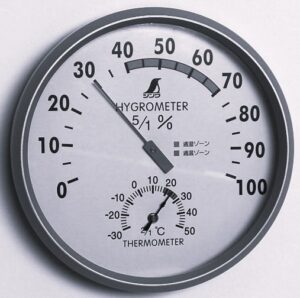
It is the measure of the moisture content of the atmosphere or the amount of water vapor in the atmosphere.
Humidity is measured with a wet and dry bulb hygrometer.
How humidity affects plants and animals
- low humidity causes land-living organisms to lose more water from their body through evaporation
- increase in humidity decreases transpiration in plants as leave cuticles are covered
- high humidity also affects the activeness of cold-blooded animals e.g., lizards
- low humidity affects wilting of plants.
Biotic Factors
These factors form the living components of a habitat. There is the interaction between organisms in many ways, some depend on others for food and shelter and some also are harmful to the community, and others too are useful.
Examples are:
- Food,
- Shelter,
- Mechanical support,
- Mating partners,
- Pollination,
- Grazing,
- Nitrogen fixation.
Ways by which biotic factors are carried out within the community
- Tall trees shelter shade-loving plants as well as animals
- Basically, herbivores feed on plants and may destroy them
- Carnivores eat other animals
- Insects and some birds pollinate flowers
- Many animals are agents of pollination
- Plants with weak stems use other plants for support for light
- Parasites live in or on the living host and may eventually cause their death
- Epiphytes grow on a living host usually a tree but do not cause any of them
- Activities of humans such as cutting trees, bush burning, clearing bushes to build houses, mining, etc.
Examples of harmful biotic factors include parasitism, carnivores’ activities (Predation), cannibalism, and human activities,
Questions for revision
Essay questions
- Explain the following;
- Population
- Habitat
- Ecosystem
- Biosphere
- Ecological niche
- List four ecological factors that are common to all habitats and state the instrument you will use to measure them.
- State four effects of each of the following factors on the ecosystem.
- Wind
- Rainfall
- Temperature
Objective Test
1, which of the following is likely to cause an increase in the temperature of an ecosystem
A. Low sunlight intensity
B. Bush burning
C. Thick cloud cover
D. Growing trees around the home.
2. All the following practices can improve the ventilation of a home except
A. Clearing of bush around the house
B. Provision of large windows in a house
C. Growing trees around the house
D. Burning of heaters in the room.
3. Ecology is the study of:
A. different species of organisms in a given area.
B. the interrelationship between plants and animals.
C. the interrelationship between organisms and their environment
D. the characteristics of habitat
4. Which of the following best describes an ecosystem?
A. Group of organisms of the same species in an area
B. Part of the earth where life exists
C. An area where living and non-living parts interacts
D. A group of different species living together in a habitat.
5. A stable self-sustaining environment produced by an interaction between the biotic and abiotic components is best described as
A. a niche
B. a community
C. an ecosystem
D. a habitat
6. Which of the following statements best describes the biosphere?
A. The dominant species in a community
B. The non-living parts of the ecosystem.
C. All ecosystems and the organisms which inhabit them
D. All the living parts of an ecosystem
7. In ecology, a community refers to
A. several individuals of a given species
B. groups of different organisms living in a habitat.
C. existing species in an abandoned farmland
D. the dominant species in a habitat
8. The instrument used to determine relative humidity is:
A. Anemometer
B. barometer
C. hydrometer
D. hygrometer
9. In an aquatic environment light intensity is measured with a/an
A. barometer
B. Hygrometer
C. light intensity probe
D. Photometer
10. The transparency of water is measured with
A. Secchi disc
B. line transect
C. rain gauge
D. light meter
11. The direction of the wind is determined by:
A. a barometer
B. Secchi disc
C. an anemometer
D. a vane
12. Which of the following instruments is not used in measuring abiotic factors in any habitat?
A. microscope
B. thermometer
C. hydrometer
D. wind vane
13. The wet-dry bulb hygrometer is used to measure
A. relative humidity
B. pressure
C. temperature
D. amount of rainfall
14. Which of the following instruments is used to measure the speed of a stream?
A. simple float
B. Secchi disc
C. quadrat frame
D. rain gauge
15. Which of the following is an abiotic factor?
A. Parasite
B. Litter
C. Predators
D. Grazers
16. Which of the following statement about abiotic factors is corrects?
A. Slope of land does not affect the growth of plants
B. Oxygen level is high at high altitudes
C. Temperature and speed of wind are directly proportional to an increase in altitude.
D. variation in the amount of rainfall results in drought and rainfall
Answer to objective test
- C. Thick cloud cover
- D. Burning of heaters in the room.
- C. the interrelationship between organisms and their environment.
- C. An area where living and non-living parts interacts.
- C. an ecosystem
- C. All ecosystems and the organisms which inhabit them
- B. groups of different organisms living in a habitat.
- D. hygrometer
- C. light intensity probe
- A. Secchi disc
- D. wind vane
- A. microscope
- A. relative humidity
- A. simple float
- B. Litter
- D. variation in the amount of rainfall results in drought and rainfall






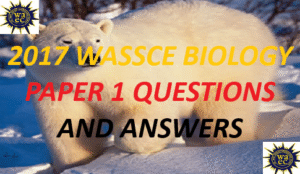
Very educative…
Good trial question 😊
Thank you